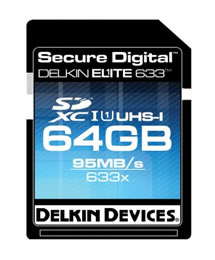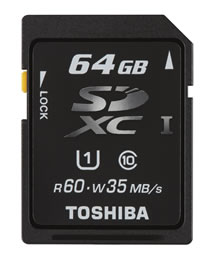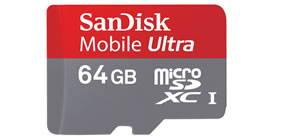microSDXC • micro SDXC Cards®
About SDXC • and small microSDXC Cards
 SDXC
SDXC
The Secure Digital eXtended Capacity (SDXC) format works with cards of up to 2TB or 2048GB, which is so much more than the maximum memory of 32GB that can be accommodated by SDHC cards with SD 2.0 specs.
Background
SDXC was first made known during the Consumer Electronics Show 2009 in January 7-10, 2009. This was also during the announcement of Sony and SanDisk about how they also have almost the same Memory Stick XC models with a maximum capacity spec of 2 TB. Panasonic also released news of plans to make 64GB SDXC cards at the same time.
Pretect then released the first SDXC card in the world on March 6, 2009. It has a 32GB memory card capacity with average read and write speeds of 400 MB/s. However, the consumers still had to wait until the first part of 2010 before compatible host systems were released to the market. These devices include Canon’s EOS 550D DSLR camera, Handycam HDR-CX55V camcorder, a JMicron DXC card reader, and a Panasonic USB card reader. Even if there are already laptops with features ready for the SDXC card, they are still using the USB 2.0 bus. This is still incompatible with the SDXC card due to the lack of bandwidth support.
In early 2010, Toshiba released commercial SDXC cards with 64GB capacity, Panasonic released 48GB and 64GB cards, and SanDisk with 64GB. In the first part of 2011, Centon Electronics, Inc. released the 64GB and 128GB SDXC cards and Lexar had the 128GB cards at Speed Class 10. Pretec still offered SDXC cards ranging from 8GB to 128GB cards with Speed Class 16.
SanDisk introduced the 64GB microSDXC card in September 2011 followed by Kingmax with almost the same product released during the same year.

From official SDXC site and home page.
" UHS-II is the interface which will be needed to reach the Maximum SDXC UHS-2 card Read and Write speeds. "
 Working with SDHC
Working with SDHC
SDXC host devices still work with other types of SD memory cards. Host devices that work with SDHC are compatible with SDXC cards that are released after Version 3.0 because they have the same interface. However, their usability may be affected by the following:
• SDXC cards already use the Microsoft patented exFAT file system, which might not work on other host devices. Since this is a patented file system and it is already licensed, the older OS or alternative systems tend not to support exFAT. If this is used on SDXC cards, the SD card may not be rendered as a universal exchange medium. It would not work with all host devices. But the FAT32 file system supports SDXC’ 2TB theoretical capacity. The SDXC card can be reformatted using FAT32 file system so it can be used on various computers and other host devices. If the memory card is already FAT32-formatted, it can be used on any host device initially developed for SDHC cards if it can handle at least 64GB.
• SDHC host devices cannot use the latest features incorporated into the SDXC cards because they do not examine the capability bits of these 4.0 cards. They would miss out on transfer speeds that are faster than 104MB/s.
• If compatibility is needed on a system that has USB but no SDXC compatible card reader a SDXC USB 3.0 adapter / multi card reader can be used. Even better micro USB3 readers for micro cards can save space while retaining the same specs. This is particularly important when talking about smart phones and tablets that have to be light, but fully featured.
Host OS Support
Windows XP SP2 or SP3 with KB955704, Windows 7, Windows Vista SP1+, Windows Server 2003 SP2 or SP3 with KB955704, Windows Server 2008 SP1+, and Windows CE 6.0 or higher support SDXC memory cards.
Mac OS X Snow Leopard 10.6.5 and OS X Lion 10.7 are Mac OS X versions that work with SDXC memory cards and exFAT file system.
Linux and BSD systems that are still compatible with SDHC cards can also support SDXC memory as well as micro SDXC cards given that they also have a workable file system. However, they usually don’t work with exFAT file system often used on SDXC memory cards because the file system is already patented to Microsoft. But with reformatting, the card may have another file system.
The Microsoft owned exFAT file system is required on SDXC cards based on its specs. However, this is only supported by proprietary OS too. exFAT is a Microsoft proprietary file system that is only used on flash drives made by Microsoft.


Compare prices and specs before you buy SDXC cards !
* SDXC, SD and SDHC Logos are trademarks or registered trademarks of SD-3C LLC in the United States and other countries of the world or both. Also, miniSDXC, microSD, miniSDHC and microSDHC microSDXC Logos are all trademarks or registered trademarks of SD-3C LLC in the United States of America and other countries of the world or both.
This website microSDXC.com is in no way endorsed, administered by, or otherwise associated with SD-3C LLC. All our reviews and opinions are ours and are not paid buy or sponsored by SD-3C LLC.